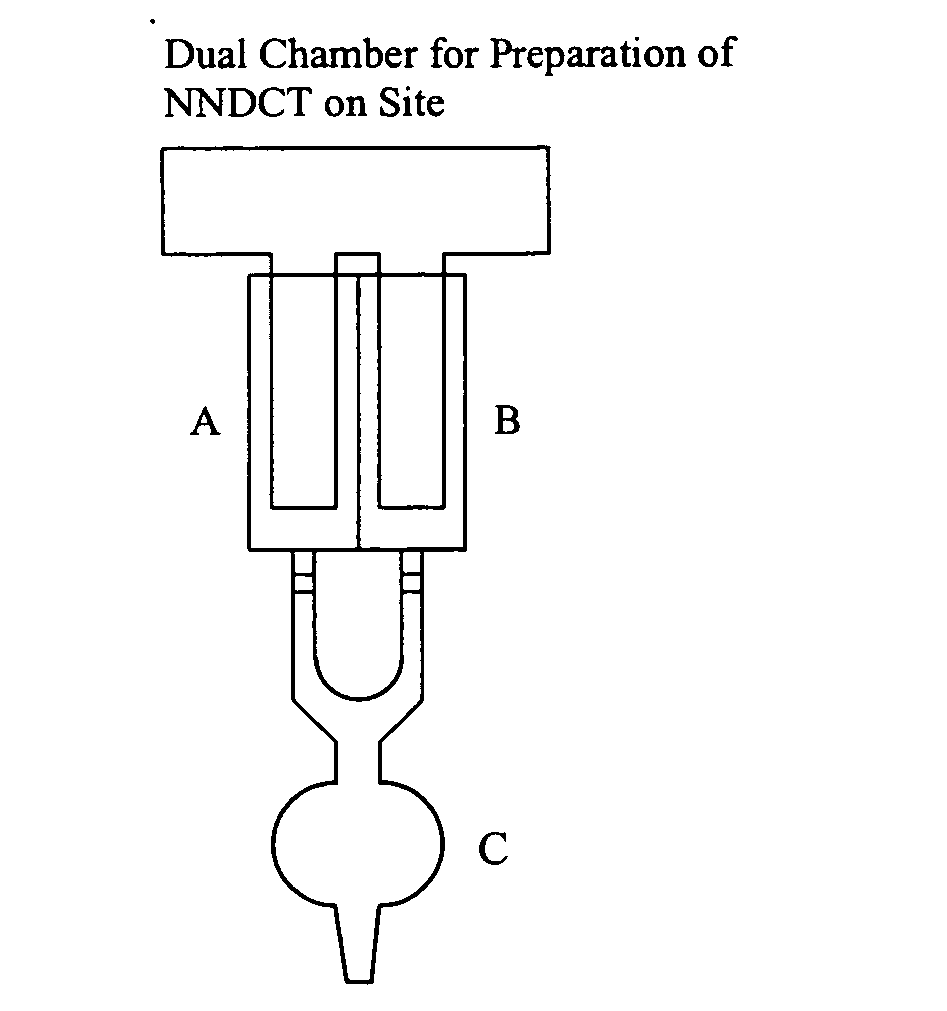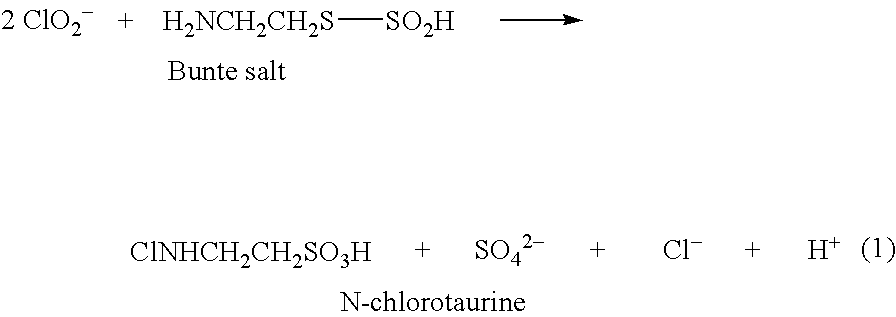N,N-dihalogenated amino acids and derivatives
a technology of di which is applied in the field of n-dihalogenated amino acids and derivatives, can solve the problem of not being able to isolate n-chlorotaurine as a pure substance, and achieve the effect of long-term stability
- Summary
- Abstract
- Description
- Claims
- Application Information
AI Technical Summary
Benefits of technology
Problems solved by technology
Method used
Image
Examples
example 2
Antimicrobial Activity
Bactericidal Activity:
To determine the bactericidal activity, we used Escherichia coli (ATCC 11229). The bacterial culture was diluted in sterile saline to prepare inocula. Various test articles were transferred to individual tubes already containing 1.0×105 to 2.0×105 Colony Forming Units (CFU) / mL bacteria and mixed by gentle vortexing and then incubated at 37° C. for 1 or 24 hours. In an attempt to mimic as far as possible the conditions, which could be produced in vivo if the test articles were used as antiseptics, bacterial plating in a Petri dish was performed immediately after the designated exposure time without the addition of a neutralizer, and independently with addition of neutralizer (as control). Thus, 0.1 mL was removed after 1 or 24 hours exposure times and plated. Plates were incubated at 37° C., and the numbers of bacteria were counted by direct colony count to numerate the surviving bacteria as CFU / mL. Positive growth controls were made w...
example 3
Cytotoxicity was assessed by a colorimetric assay system, initially described by Scudiero et al., using 3′-(phenylamino-carbonyl)-3,4-tetrazolium-bis (4-methoxy-6-nitro) benzene sulfonic acid hydrate (XTT), ProCheck™ cell viability assay (Evaluation of a soluble tetrazolium / formazan assay for cell growth and drug sensitivity in culture using human and other tumor cell lines described by Scudiero D A, Shoemaker R A H, Paul K D, Monks A, Tierney S, Nofziger T H, Currens M J, Seniff D, Boyd M R. Cancer Res. 1988 Sep 1;48(17):4827-33). Similar approaches for determining the cell viability are used by other investigators. Three cell types were used: mouse lung epithelial cells (L929), primary human skin fibroblast and primary human keratinocyte cells cultured in Dulbecco Modified Eagle's Medium and Keratinocyte defined medium with corresponding growth factors plus antibiotics. Cells were trypsinized and counted under the microscope and seeded at 1000-to-2000 cells p...
example 4
As an example, the procedure for the preparation of N,N-dichloro-1,1-dimethylethanesulphonic is described as follows:
Step 1. Synthesis of 1,1-dimethylethanesulphonic acid (Braghiroli, D.; Bella, M. D. Tetrahedron Letters, 1996, 37, 7319-7322).
1,1-dimethylethanesulphonic acid is prepared by reduction of 2-hydroxyisobutyronitrile (acetone cyanohydrin) to 1-amino-2-methyl-2-propanol, followed by protection with (Boc)2O. After mesylation and removal of the protecting group, the hydrochloride obtained was allowed to react with sodium sulfite to give 1,1-dimethylethanesulphonic acid.
Step 2 Chlorination of 1,1-dimethylethanesulphonic acid.
To make 1 liter of 1.6 mM of N,N-Dichloro-1,1-dimethylethanesulphonic acid (NNDC-DMESA) in 0.9% NaCl solution at pH 3.5, add 8.6 g of NaCl into a 1000 -ml volumetric flask, then add 500 ml Millipore water into the flask to dissolve the salt. Add 2 ml of 1 M HCl into the NaCl solution, followed by adding 22 ml of 0.158 M NaOCl. Mix the solution. T...
PUM
| Property | Measurement | Unit |
|---|---|---|
| composition | aaaaa | aaaaa |
| concentration | aaaaa | aaaaa |
| pH | aaaaa | aaaaa |
Abstract
Description
Claims
Application Information
 Login to View More
Login to View More - R&D
- Intellectual Property
- Life Sciences
- Materials
- Tech Scout
- Unparalleled Data Quality
- Higher Quality Content
- 60% Fewer Hallucinations
Browse by: Latest US Patents, China's latest patents, Technical Efficacy Thesaurus, Application Domain, Technology Topic, Popular Technical Reports.
© 2025 PatSnap. All rights reserved.Legal|Privacy policy|Modern Slavery Act Transparency Statement|Sitemap|About US| Contact US: help@patsnap.com



